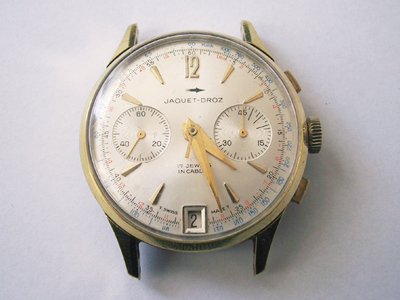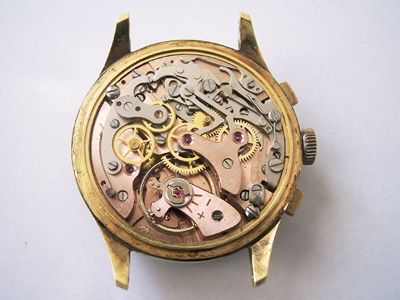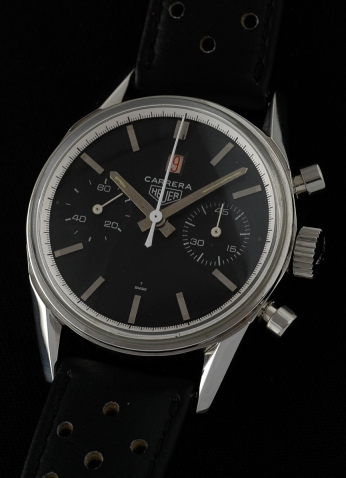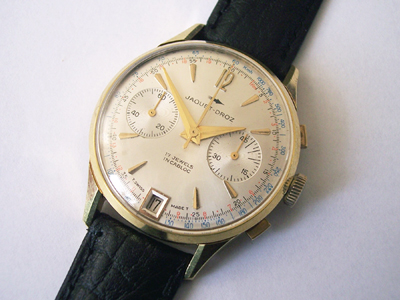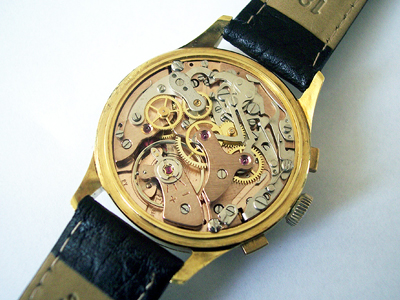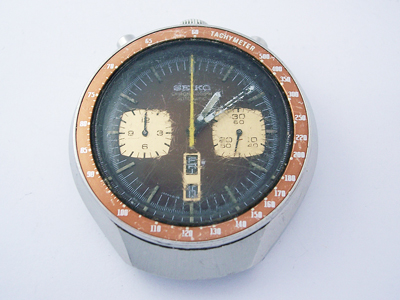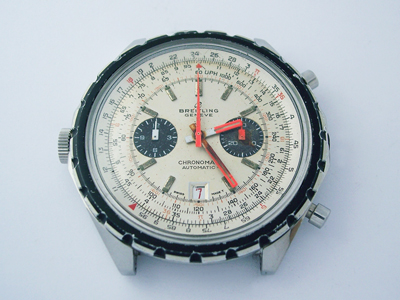Another vintage chronograph that I fished out of “the bay”, this time from Jaquet-Droz.
(Click pictures to enlarge)
The history of Jaquet-Droz is colourful to say the least. Pierre Jaquet-Droz opened his first studio in La Chaux-de-Fonds in 1738 where he specialised in automata, or ‘self operating machines’. He started by adding singing birds to clocks and pocket watches and as his talent grew, he moved on to larger, more technical pieces, i.e. richly decorated bird cages with multiple automated song birds.
A trip to Spain in 1758 proved very lucrative for Pierre. The King of Spain was so enchanted with his automata that he bought his entire collection, enabling him to open a second studio in London and devote all his time to his craft. Consequently, his reputation spread rapidly and his creations found their way into many European courts.
His three most elaborate creations are referred to as the ‘Jaquet-Droz Automata‘ and can be seen at the Musée d’Art et d’Histoire of Neuchâtel, in Switzerland – “The Draughtsman” draws four different images, “The Musician” is a female organ player who physically plays the tunes rather than miming to a music box, and the most complex of the three is “The Writer”, who can be ‘programmed’ to transcribe any 40 character message. Here is a short video of the three of them in action.
https://www.youtube.com/watch?v=bY_wfKVjuJM
Pierre died in 1790, shortly after opening a watchmaking factory in Geneve with his son Henry-Louis. Tragically, his son also died the following year while traveling and this had a devastating effect on the company, which ceased trading sometime in the early 1800’s.
The Jaquet-Droz name was resurrected in the 1960’s by a consortium who produced a range of chronographs and diving watches. Unfortunately, the company was hit by the quartz crisis and closed before it really got started. (Watches from this period, like the one in this post, can be recognised by the arrow logo.)
Like a phoenix from the ashes, Jaquet-Droz rose yet again in 2001 when the name was bought by the Swatch group. Since then the company have produced a range of dress watches and chronographs with in-house calibres. You can see their current range here.
Ok, back to the watch. By the 1970’s, whistling birds and other such tom-foolery were no longer incorporated, but removing the caseback did reveal an unexpected surprise, a rhodium plated Landeron cal. 189.
The cal. 189 is one of the rarer Landeron calibres, and was used in very few production watches, the best known probably being the Heuer Carrera Dato 45.
The cal. 189 differs from other Landeron calibres in that it has a date display, and operates like a regular chronograph; the top button is used for start/stop and the lower button resets. On most Landeron chronographs the top button starts the mechanism and the bottom button is used for stop and reset.
Overall, the watch was in relatively good condition but hadn’t been serviced for years, so after a routine service it was back up and running again.
Cosmetically it was still in good condition, but you may have spotted in the first picture that the sweep second hand had been broken off at some time. After that was replaced, there was little left to do except clean the case and polish the crystal.
Rich.

